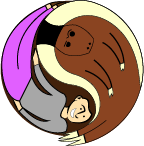The Short of It:
The best forms are formless.

11. the use of non-existence.
Thirty spokes unite in one nave, and by that part which is non-existent (i.e. the hole in the centre of it) it is useful for a carriage wheel. Earth is moulded into vessels, and by their hollowness they are useful as vessels. Doors and windows are cut out in order to make a house, and by its hollowness it is useful as a house. So then existence may be said to correspond to gain, but non-existence to use.
11. ‘the use of what has no substantive existence.’
The thirty spokes unite in the one nave; but it is on the empty space (for the axle), that the use of the wheel depends. Clay is fashioned into vessels; but it is on their empty hollowness, that thier use depends. The door and windows are cut out (from the walls) to form an apartment; but it is on the empty space (within), that its use depends. Therefore, what has a (positive) existence serves for a profitable adaptation, and what has not that for (actual) usefulness.
11. the function of the non-existent.
11.1 Thirty spokes unite in one nave and on that which is non-existent [on the hole in the nave] depends the wheel’s utility. Clay is moulded into a vessel and on that which is non-existent [on its hollowness] depends the vessel’s utility. By cutting out doors and windows we build a house and on that which is non-existent [on the empty space within] depends the house’s utility.
11.2 Therefore, existence renders actual but non-existence renders useful.

